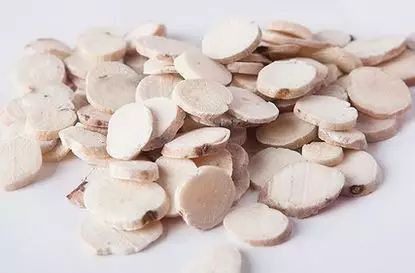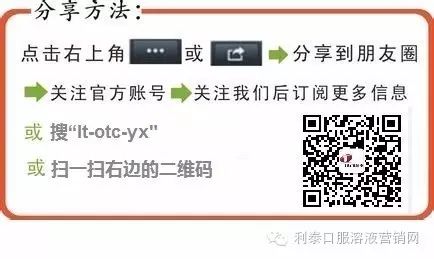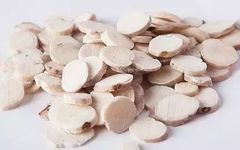Core Insight: Bai Shao (White Peony) has a bitter and sour taste, with a slightly cold nature. Its effects include nourishing blood and softening the liver, alleviating pain and spasms, and can be used for chest and abdominal pain caused by liver qi stagnation, as well as for muscle spasms in the hands and feet.
The peony flower is large and colorful, beautiful and pleasing to the eye, yet it has always played a supporting role under the shadow of the king of flowers, the peony, often referred to as the “flower counterpart.” In recent years, the significance of the Qixi Festival has grown among young people, and the line from the “Book of Songs” that says, “When a man and a woman meet, they exchange gifts of peonies” has gradually been understood, indicating that love between men and women is no longer solely adorned with roses but also carries the fragrance of peonies. In fact, the peony is a very distinctive flower, and among the myriad of flowers, it is one of the few with the character for medicine in its name, truly serving as a remedy in the hands of healers. Bai Shao is widely used for nourishing blood, softening the liver, benefiting the stomach, and for beauty and health care, particularly in treating chest and abdominal pain, dysentery, spontaneous sweating, night sweats, yin deficiency heat, menstrual irregularities, metrorrhagia, and leukorrhea.

Bai Shao Grows Best in Hangzhou
Bai Shao is very common and cultivated throughout the country. The commonly used varieties include “Bo Bai Shao” from Bozhou, Anhui, and “Hang Bai Shao” from Pan’an, Zhejiang. Bai Shao is harvested in summer, with the heads and tails cut off, the outer skin removed, briefly boiled in hot water, then dried and sliced for medicinal use. It can be used raw, stir-fried with soil, or stir-fried with wine. Raw Bai Shao is used for nourishing yin, softening the liver, replenishing blood, and benefiting the stomach; wine-fried Bai Shao is used for harmonizing the middle and alleviating pain; soil-fried Bai Shao is used for calming the spleen and stopping diarrhea.
According to the “Bencao Qiuzhen,” “Bai Shao from Hangzhou is the best,” but with the passage of time, Bai Shao has become a commonly used cultivated medicinal material. Areas like Pan’an and Jinyun in Zhejiang have large-scale cultivation, especially in Pan’an, where the geographical environment is very suitable for Bai Shao growth, leading to widespread cultivation across towns and becoming the main production area for Hang Bai Shao, with the quality of the harvest being the best in the country.
However, as mentioned in “Bencao China,” although the quality of “Hang Bai Shao” from Pan’an is excellent, it is constantly impacted by “Bo Bai Shao.” The planting area of Bozhou Bai Shao is more than ten times that of Hang Bai Shao, and it has a shorter growth period. Therefore, although Hang Bai Shao is of superior quality, it has no competitive advantage in the fierce price competition. According to “Bencao China,” Chen Fengyang from Pan’an has been planting Bai Shao since he was 17 years old and is now in his seventies, still insisting on cultivating it. He says that even if he incurs losses, he must plant it, as he wants to ensure that Hang Bai Shao, this “authentic medicinal material,” is passed down during his lifetime.
White Peony Flower Gardener in Anhui
There is a widely circulated legend about Bai Shao in Bozhou, Anhui. It is said that during the Tang Dynasty, there was a young gardener who loved a wild flower with pink petals and golden stamens but did not know its name. He asked a private school teacher to name it, and it was called Shao Hua (Peony Flower). After Wu Zetian became emperor, she summoned the most famous gardeners in the world to plant flowers for her in the palace, and this gardener was among them, bringing along his beloved Shao Hua.
In the palace, all the flowers flourished under careful care, but the Shao Hua longed for its homeland and gradually withered. The gardener could not bear to see his beloved flower wilt, so he tended to it diligently. His efforts were rewarded, and the Shao Hua finally bloomed again, but the gardener fell ill from overwork. One night, he dreamed that a beautiful young woman emerged from the blooming Shao Hua, holding a silk handkerchief, and came to his bedside saying, “You have worried and labored for me to the point of illness; I will give you my flower root to cure you.” Saying this, she handed him the Shao root wrapped in the silk handkerchief. When the gardener woke up, the woman had vanished, but the flower root remained. After he brewed the root in water and drank it, he recovered the next day. To thank the Shao Hua fairy, the gardener renamed the flower “Bai Shao” (White Peony).
Later, the gardener, missing his hometown, took Bai Shao back to Bozhou, Anhui, and had a son whom he named “Bai Shao.” Since then, Bozhou has become the hometown of Bai Shao. I believe this is a touching story created by well-meaning people in Anhui to promote Bozhou Bai Shao.
Bai Shao Excels in Nourishing Blood and Alleviating Pain
In the Song Dynasty, the literati Shen Zuozhe had a Q&A about Bai Shao in his work “Yu Jian.” The question was: People love to admire flowers and view peonies, but I want to ask, is there a difference between the red and white roots of peonies, is it a difference in variety? The answer was: Bai Shao receives the pure yang energy, thus it is white and good for replenishing; doctors use it to generate blood and alleviate pain; Chi Shao (Red Peony) receives incomplete yang energy, thus it is red and good for purging, its effects are not comparable, this is the natural principle.
This question and answer affirm Bai Shao’s main functions: nourishing blood and alleviating pain.
Bai Shao has a bitter and sour taste, with a slightly cold nature. Its effects include nourishing blood and softening the liver, alleviating pain and spasms, and can be used for chest and abdominal pain caused by liver qi stagnation, as well as for muscle spasms in the hands and feet. For treating rib pain, it is often used with Chai Hu (Bupleurum) and Zhi Ke (Bitter Orange); for abdominal pain and muscle spasms, it is often paired with Gan Cao (Licorice). Modern liver disease expert Guan Youbo has an empirical formula called Jian Pi Shu Gan Wan, which includes Bai Shao, Dang Shen (Codonopsis), Huai Shan Yao (Chinese Yam), Chao Yi Yi Ren (Job’s Tears), Chen Pi (Aged Tangerine Peel), Dang Gui (Angelica), Chai Hu, and Yu Jin (Turmeric). Its effects are to strengthen the spleen, open the stomach, and soothe the liver, specifically treating the recovery phase of liver disease when liver function has returned to normal but digestive function has not fully recovered, presenting symptoms like fullness in the chest and ribs, poor appetite, and fatigue. For chronic liver disease patients with hidden pain under the ribs, one can take 6 grams of Bai Shao flowers and 50 grams of japonica rice, boil them in water to make congee for auxiliary treatment.
Nourishing Qi and Blood for Beauty
When it comes to nourishing blood, one must naturally mention beauty.
Blood is the foundation of health and beauty in the human body. Those with blood deficiency often have a yellow or pale complexion, dull lips, and lack of rosy nails, making it difficult to achieve a healthy, radiant complexion.
In TCM blood-nourishing formulas, Bai Shao is often used, such as the famous Si Wu Tang (Four Substance Decoction) in the “Taiping Huimin Heji Ju Fang,” where Bai Shao is combined with Shu Di Huang (Rehmannia), Dang Gui, and Chuan Xiong (Ligusticum) to nourish blood and regulate menstruation. The physician Li Dongyuan mentioned Bai Shao, stating: “To nourish the liver is to regulate the blood,” hence the use of Bai Shao in Si Wu Tang. Individuals can also prepare at home 12 grams of Shu Di, 9 grams of Bai Shao, 6 grams of Dang Gui, and 6 grams of Chuan Xiong, adding 3 red dates, boiling in water for 1 hour, and using the water to brew rose tea for drinking, which is beneficial for beauty.
The Ming Dynasty medical text “Yixue Rumeng” records a formula called San Bai Tang, which includes Bai Shao, Bai Zhu (Atractylodes), Bai Fu Ling (Poria), and Gan Cao, boiled in water and taken warm. This formula was originally used to treat febrile disorders and restlessness, but later it was discovered to nourish qi and blood, whiten and moisturize the skin, and is used for beauty and health care. Bai Shao has a sweet and sour taste, with a slightly cold nature, and has blood-nourishing effects. When used in combination with Bai Zhu and Fu Ling, it has a whitening effect. Young women who love beauty can directly brew Bai Shao flowers in tea for treating facial spots.
Nourishing Yin and Benefiting the Stomach
Another classic formula featuring Bai Shao is Shao Yao Gan Cao Tang, which utilizes Bai Shao to nourish blood, astringe yin, soften the liver, and alleviate pain; Gan Cao supplements the middle, benefits qi, clears heat, detoxifies, and alleviates pain. Physicians evaluate this formula, stating that Bai Shao has a sour taste, receiving the purest wood energy; Gan Cao has a sweet taste, receiving the thickest earth energy. The combination of these two herbs has the unique effect of harmonizing yin and nourishing blood, alleviating pain. Physician Zhang Jiegugu once said: “Bai Shao and Zhi Gan Cao are the divine medicines of Zhang Zhongjing. In summer, for abdominal pain, add Huang Qin (Scutellaria); for heat-induced abdominal pain, add Huang Bai (Phellodendron); for cold-induced abdominal pain, add Rou Gui (Cinnamon).”
Another famous formula in the “Shang Han Lun” is Xiao Jian Zhong Tang, which also contains Bai Shao, serving as a warming and nourishing agent, alleviating pain, and harmonizing yin and yang, primarily treating middle jiao deficiency and cold, liver and spleen disharmony, abdominal cramping pain, preference for warmth and pressure, fatigue, and shortness of breath. It is now often used for gastric and duodenal ulcers, chronic hepatitis, chronic gastritis, neurasthenia, aplastic anemia, and functional fevers associated with middle jiao deficiency and liver-spleen disharmony. The Jian Pi Yin recorded in the “Bian Zheng Lu” includes Bai Shao, Huai Shan Yao, Tai Zi Shen (Pseudostellaria), Chao Yi Yi Ren, Bian Dou (Hyacinth Bean), Mai Ya (Barley Sprout), Lian Zi Rou (Lotus Seed), Shan Zha (Hawthorn), Nei Jin (Endosperm), Ge Gen (Kudzu), and Da Zao (Jujube), with a sweet and sour, gentle and moistening nature, nourishing the spleen and promoting the rise of yang, nourishing yin and harmonizing the blood. Its properties are mild, making it suitable for treating spleen and stomach deficiency, abdominal distension, poor appetite, especially in children with digestive disorders, often used as the main formula with appropriate modifications, which children can accept happily and with good results.
Imperial Formulas Favor Bai Shao
In the “Cixi Guangxu Medical Formula Selection,” several imperial prescriptions include Bai Shao. In the 30th year of Guangxu, Empress Dowager Cixi experienced dizziness and slight pain, and the imperial physicians Zhuang Shouhe and Yao Baosheng formulated a heat-clearing, liver-nourishing, and meridian-activating ointment, which included Xie Sheng Di (Fresh Rehmannia), Hang Bai Shao, and Jiu Dang Gui (Wine-Processed Angelica), used to treat liver heat conditions. Among them, Bai Shao was the main herb for nourishing liver yin and clearing liver heat.
Subsequently, Empress Dowager Cixi also took another ointment primarily composed of Bai Shao and Sang Ye (Mulberry Leaf) for clearing heat, nourishing the liver, and activating the meridians, focusing on cooling the liver and activating the meridians. On May 19 of a certain year in Guangxu, Zhang Zhongyuan prescribed another ointment for regulating the liver and stomach, which included Dang Shen, Sheng Hang Bai Shao, and Jin Shi Hu (Dendrobium). This formula was commented on by Academician Chen Keji as: “Regulating the liver and stomach, heavily using Sheng Hang Shao, precisely addressing the liver yin deficiency and spleen-stomach disharmony of the Empress Dowager.” This shows the experts’ affirmation of Bai Shao’s functions in nourishing the liver and stomach. Additionally, it is recorded that both Cixi and Guangxu took ointments primarily composed of Bai Shao for clearing heat and transforming dampness to regulate the spleen and stomach.


The OTC Sales Department of Guangdong Litai Pharmaceutical is dedicated to promoting good articles, and the content is for learning and communication purposes only, maintaining neutrality regarding the viewpoints expressed in the article. The copyright of the article belongs to the original author or institution; if there are any copyright issues, please contact us for removal.


